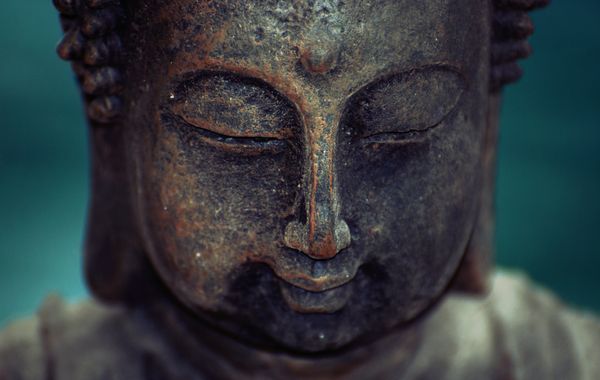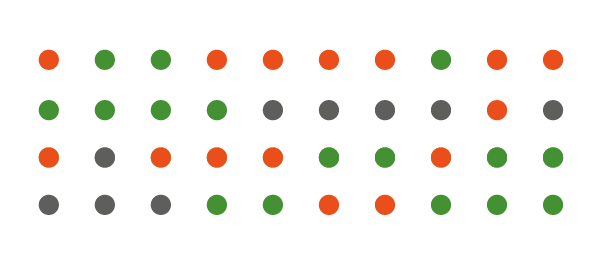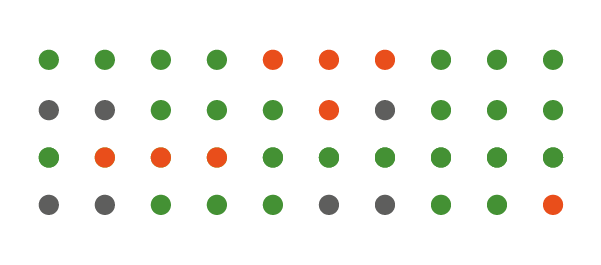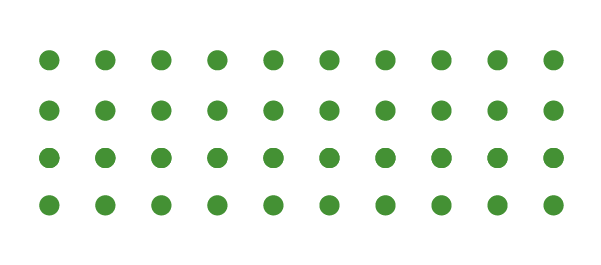Giovanni Dienstmann • • 10 min read
How to Deepen Your Meditation to Achieve Altered States of Consciousness

In every meditation tutorial, at some point the author will tell you:
“There is no such thing as good meditation or bad meditation.”
Great.
Encouraging.
You can’t go wrong.
But…
Let’s be real for a moment.
This definitive “meditation rule” isn’t so black and white.
For example:
• What happens when your meditation stops resembling meditation?
• What happens when you’re going through the motions but instead of meditating, you’re really just napping in a semi-conscious twilight zone?
Or worse, you just read a “benefits of meditation” article and now feel that setting your timer for 20 minutes and simply breathing is gonna make you superhuman.
Not so.
Allow me to make one subtle but much-needed alteration to that old meditation maxim:
“There is no such thing as good or bad MEDITATION.”
Bad meditation is still meditation. But non-meditation, that’s bad meditation.
For example, if I told you there was no good or bad type of exercising, you wouldn’t go sit on the couch, watch 2 hours of TV and class that as exercise, would you?
(please say no.)
Exercising, broadly speaking, is good, but there is an effective and ineffective way of exercising.
Same with meditation.
But, let’s not get engulfed in the endless semantic whirlpool of moral meditation: good, bad, average…
The point is, there is no bad type of
meditation, as long as you’re actually
meditating.
You don’t judge the experiences and feelings you are having during meditation as “good” or “bad”; instead, you just focus your attention on actually doing the practice properly.
I’m going to assume you already have the motivation to set aside some time each day to meditate and you know the basics (this ultimate beginner’s guide will fill you in if you don’t).
This article is a meditators guide to meditation. If you’re a beginner, after reading this you’ll have a solid foundation as you progress; if you’re intermediate, you’ll learn how to deepen your practice; if you’re advanced, you’ll learn a few new tips and tricks to try out on your journey.
3 Ways You’re Ruining Your Meditation…
When you break it down, there are three main reasons why your meditation might suck:
- Lack of preparation before practice
- Your daily habits and attitudes are not supporting your practice
- Not enough intensity of focus during practice
The first point is about what you do before practice; the second is what you do outside of your practice; the third is about the meditation process itself the how of focusing attention.
But before we get to the exact ways you can optimize these three core concepts let’s have a look at…
The Process of Meditation
The reason why your meditation doesn’t go deep, or is not clear enough, is lack of intensity which, is a result of not fully understanding the process of meditation. It is a form of torpor (laziness) or sloth, which is one of the “five hindrances” of meditation, according to the Buddhist tradition.
The mind has two main functions, ‘doing’ and ‘knowing’. The way of meditation is to calm the ‘doing’ to complete tranquility while maintaining the ‘knowing’. Sloth and torpor occur when one carelessly calms both the ‘doing’ and the ‘knowing’, unable to distinguish between them. – Ajahn Brahmavamso
Suppose you meditate by focusing on your breath for 10 minutes (600 seconds). Let’s visually represent your meditation as a square on a paper, filled with 600 dots. When you are about to start meditation, they are all blank.

Each second of your meditation can only be spent in one of three ways. Either with the object of focus (in this case, the breath), with another object (for example, a thought or memory), or neither focused nor distracted – a kind of “blanked out” state.
Let’s represent these with colors:
- For each second you focus on your breath you get a
- For each second you are engaged in thoughts you get a
- For each second you are in a blank state of mind you get a
Your objective is to fill that square with as many green dots as possible. The more green dots you have, the deeper and clearer your meditation feels. If it is filled with red dots, your meditation was “noisy” and all you get from it is simply bodily relaxation. If it is filled with gray dots, meditation is “calm but clouded”.
Some people confuse this “gray state” with the real quietude of meditation, but it’s not (more about this later).
As a beginner – or as an advanced meditator, in the first minutes of practice – your session may look like this:

As time passes, and you brush up your concentration skills, your meditation starts to look more like this:

The goals of the practice, for the meditator, is to gently:
- Decrease the number of consecutive reds (meaning the time needed for us to realize that we got distracted gets shorter)
- Increase the overall number of greens (pure concentration moments)
- Increase the number of consecutive greens
- Decrease the number of grays
If your meditation doesn’t ever look like this, that’s absolutely fine. What’s important is the striving.
“Chaos is inherent in all compounded things. Strive on with diligence.”
– Buddha
For those familiar with the Hindu teaching of the three gunas (which are the basic characteristics of building blocks of all existence), we can say that:
greenis sattva (purity, balance, serenity, openness, clarity, presence, awareness)
redis rajas (activity, dynamism, movement, agitation, restlessness)
grayis tamas (torpor, sloth, inertia, obfuscation, heaviness, forgetfulness)
I hope this gives you a better understanding of the process of meditation.
Jon Kabat-Zinn, in his seminal book Mindfulness for Beginners, goes very deep into the process of meditation if you’d like to learn more on this.
For most people, after they get 3 green dots, they relax their focus, and then their mind wanders. Thus, there is no intensity, leading to limited results.
Your attitude during meditation should be to re-focus the attention second after second on the object of your meditation. At the “end” of each green dot, you need to be particularly vigilant because it is easy for the mind to slip into agitation or forgetfulness.
The key to deepening in meditation is to affirm and reaffirm your object of focus second after second, in a continuous flow of attention.
Of course, this is by no means easy. It takes sustained training to achieve. But having a clear understanding of the process can help you progress faster. Unfortunately, I didn’t find this process laid out like this anywhere; it took me some time to connect the dots (intentional pun).
Generating More Intensity
Whenever you have a deep sense of interest, focus is a natural by-product.
Sloth and torpor are overcome by rousing energy. Energy is always available, but few know how to turn on the switch, as it were. Setting a goal, a reasonable goal, is a wise and effective way to generate energy, as is deliberately developing interest in the task at hand. A young child has a natural interest, and consequent energy, because its world is so new. Thus, if one can learn to look at one’s life, or one’s meditation, with a ‘beginner’s mind’ one can see ever new angles and fresh possibilities which keep one distant from sloth and torpor, alive and energetic. […] Sloth and torpor is a common problem which can creep up and smother one slowly. A skilful meditator keeps a sharp look-out for the first signs of sloth and torpor and is thus able to spot its approach and take evasive action before it’s too late. – Ajahn Brahmavamso (Wikipedia)
If your meditation is focusing on the breathing, you need to generate deep interest for the breath. You need to want to know your breath deeply. You must yearn to experience it on many levels, again and again.
Keeping the interest alive and intense is the secret. You need to be more interested in exploring your breath than in rehearsing thoughts and memories in your mind.
As our focus goes deeper, what we before saw it as a single dot (green, red or gray), we realise that it’s actually a collection of hundreds of mini-dots, or milliseconds of attentional movement. So when we say that we got a green dot or a red dot, what it means is that for the majority of milliseconds of that dot, attention was green or red. But this is probably only relevant for more advanced meditators.
For this reason, chose among the traditional types of meditation, one that your mind is naturally attuned to. That will help you keep your interest alive.
A metaphor that can help you get a better experience this intensity of focus is this:
Imagine you are walking on a rope, suspended over a cliff. You need your full attention every step of the way – every second of each step. A single moment of distraction, and your body loses balance and you fall.

If we could “walk” our meditation with this level of intensity we would have no problem in attaining deeper levels of meditative absorption and clear vision.
The main factor in dhyana is to keep the mind active in its own pursuit without taking in external impressions or thinking of other matters. – Ramana Maharshi (Talks, 61)
Read: How Mindfulness Cultivates Courage
Keep your focus on your breath second after second, as if something extraordinary is about to happen at any moment, and you cannot miss it for the world. If you have this attitude, your meditation will be deep and beautiful, and thoughts will subside.
Balancing Intensity with Gentleness
Having an idea of how intense meditation can be, and being able to actually go that deep, are different things.
We must not feel bad about our inability to concentrate, or about “how far we are” from ideal states. It’s important to have a good north in our practice, to know what it’s possible, so we keep pushing our boundaries. However, ultimately all we need to do is to simply give the best of ourselves at each step of the way.
Self-punishment, self-criticism, and feeling bad about ourselves are part of the obstacles that come in meditation and in many activities in life. We must not give in to this type of thinking in meditation, but simply gently bring our attention back to our object of focus, as soon as we notice it has wandered. Slowly increasing the number of greens, and decreasing the reds, is what we are looking for.
If you have a natural tendency towards self-criticism, Loving-Kindness meditation might be something you want to try.
Finally, even bad meditation is good. In a world where most of us are already constantly distracted, restless, agitated and busy, having a few minutes each day to just sit still will already, by itself, bring heaps of benefits, even if our focus is not that good.
There is transformative power in the meditation posture itself. Simply sitting motionless and trying your best to regulate your attention goes a long way.
Gray States
When there is no understanding of the process of meditation, or no emphasis in concentration or regulation of attention, those that continue practicing for long get more into “gray states”. This happened several times in my meditation journey, especially in the beginning, so I speak from experience.
These states lack the one-pointedness and rock-solid aliveness of consciousness; instead, attention is more in a quiet, stand-by state. Sometimes discursive thinking is absent, but often there is a continuous thread of more “subtle” thinking, which usually goes unnoticed. Sometimes they transition into sleepiness or even napping.
Gray states also feel like peace, and many of the benefits of meditation – especially the physical ones – still happen. There is nothing inherently wrong with these states; but some meditation masters consider them a “waste of time”.
Those that follow an “effortless” approach to meditation usually meditate in the grey state for their entire life.
These states are often expressed in terms of “It was so quiet that I didn’t know anything” or ” I don’t remember what was happening… it is like I was not there.” The tricky thing is that people that are experiencing genuinely advanced states of meditation may express their experience in very similar terms – but the state is completely different. In the case of the advanced state of meditation that goes into a “no-thingness”, there is still a very intense of conscious presence and one-pointedness.
If you are looking for simply some inner calmness, relief from stress, deep rest, and other physical benefits, you’ll probably be happy with these states. But if you are looking for deep internal transformation, self-mastery, transcendence – they some back to the green as soon as you notice you have left the meditation focus.
The advanced stage of meditative absorption known in the Hindu tradition as savikalpa samadhi is like a continuous flow of green dots in concentration. Effort is still there. On the other hand, in the highest state, known as seed-less absorption or nirvikalpa samadhi, there is no more effort, no attention, no meditator, and no object of meditation. We can say (I speculate), that this is like having empty dots (neither green, nor red, nor gray).
Conclusion: effort must be directed to being with your object of meditation for as long as possible.
Parting words
It is said that if you can meditate with perfect concentration for 10 minutes, on the 11th minute you will be in samadhi.

A completely green square is not to be expected. It’s simply a continuous process of exercising this muscle of attention, and my hope is that this article helped clarify the scope of this amazing exercise.
Are you an advanced practitioner? Your feedback will be more than welcomed.
Is this how you perceive meditation as well?










